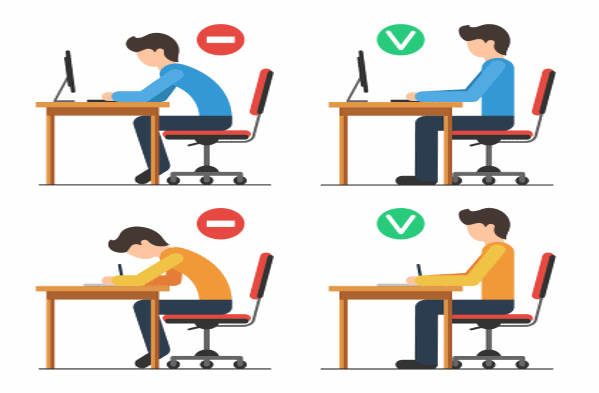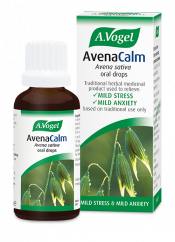How does stress cause back pain?
Let's look at the logical progression of how stress causes muscle pain and tension.
Being anxious activates the body’s stress response which causes us to become tense and more resilient in order to fight, freeze or flee from a perceived danger. It also creates a cascade of chemical changes in the body, which in turn, lead to muscle tension, muscle spasm and consequent back, shoulder and neck pain, as shown in this chart:
The greater the degree of stress response, the tighter the muscles are likely to become. If the body remains in a state of elevated stress, the muscles can become so tight that chronic pain, stiffness and soreness are likely to ensue. Furthermore if they remain in this state of tension for some time, muscles are more susceptible to spasm and 'locking up' as well as further strain and damage, which will exacerbate any existing weaknesses.
Any muscle, or group of muscles, can suffer the consequences of stress, particularly those in the neck, shoulders, upper, mid and lower back. Here are some key reasons why:
Shoulders and neck
Have you ever had a massage and cringed at the pain across your neck and shoulders? When we are stressed we tend to subconsciously hold our shoulders in a raised position which can shorten and tighten the muscles in the neck and shoulder area.
The muscles become strained, particularly at the tendons, where they join the bone at the back of the skull resulting in aching shoulders and a sore neck.
Mid and upper back
Under stressful conditions we tend to take short, shallow breaths and by failing to breathe deeply from our abdomen we breathe instead through our chest and diaphragm causing the muscles in this area to also shorten and tighten impacting both the mid and upper back.
Lower back
The lower back comprises of a large complex group of muscles which hold up the spine and help us with flexibility and movement. When we are under stress, we may change our behaviours and posture, including the way we sit, the way we move and the way we sleep. Our interest in exercise may lessen too and this combination can increase strain, stiffness and soreness in our lower back.
The vicious cycle
Stress and back pain create a vicious circle. Stress makes us prone to worry and so does pain. The more pain we have, the more we worry and the more we worry, the greater the tension in our muscles. Furthermore, those who suffer with anxiety tend to have a more sensitive nervous system and a heightened awareness of pain and odd body sensations.
Many doctors who specialise in back problems are now seeing a direct correlation between stress and chronic back problems. Dr. Sarno, Professor of Rehabilitation Medicine at New York University School of Medicine is one of the most noteworthy, and his theory suggests that if we do not deal with emotional stress at the time it happens we are likely to push it out of our conscious awareness and into our unconscious, where it begins the familiar cascade of chemical changes as shown in the flow chart above.
Symptoms of stress-related back pain
If you are experiencing chronic back pain, seek out a diagnosis from your doctor as stress is obviously only one of many possible causes. It may be useful to know that typical characteristics of stress-related back and neck pain, include symptoms such as:
- Diffuse muscle aches
- Muscle tender points
- Soreness, stiffness, spasm
- Sleep disturbance and fatigue
In many stress-related back pain cases, patients complain of the pain “moving around.”
Diagnosing back pain
Your GP will ask you about your symptoms and examine your back, assessing your ability to sit, stand, walk and lift your legs, as well as testing the range of movement in your back.
Your GP may also ask you about any illnesses or injuries you may have had, as well as the type of work you do and your lifestyle. Below are some of the questions your GP may ask:
- When did your back pain start?
- Where are you feeling pain?
- Have you had back problems in the past?
- Can you describe the pain?
Treatments
Once you have a diagnosis of stress related back pain it is most important to begin addressing your stress levels and building a toolkit of techniques to help:
Stretching and breathing
If tightness, tension and shallow breathing increase pain and spasm, then keeping muscles flexible and breathing properly are crucial.
Stretching loosens tense muscles and strengthens those that need support. If you are in any doubt about which exercises help, ask your GP to refer you for physiotherapy as some exercises can help but others could worsen the pain.
The key to stretching is that it should be gentle and if it hurts, stop. Further information can be found here, via our muscles and joints pages: http://www.avogel.co.uk/health/muscles-joints/back-pain/exercises/
A.Vogel’s Muscles & Joints advisor Earle Logan recommends:
 When you've had a particularly stressful day, neither slump in the chair for the duration of the evening, nor head out and attempt to 'release' all your tension at the gym. Instead, keep the mind and muscles mobile with just 30-60 minutes swimming, yoga or Pilates."
When you've had a particularly stressful day, neither slump in the chair for the duration of the evening, nor head out and attempt to 'release' all your tension at the gym. Instead, keep the mind and muscles mobile with just 30-60 minutes swimming, yoga or Pilates."
The time this affords you and the focus needed will mean you finish your day having broken the pattern of stress, making for a more relaxed evening and a better night's sleep, both vital intervals between stressful episodes.’
Keep an eye on your posture, especially taking care of how you stand and sit (see diagram below), take full deep breaths and once you get the hang of it, you may be surprised how this combination can help ease back pain quickly sittingand effectively

Yoga and Pilates can be very therapeutic.Yoga addresses tightness and imbalances, increases body awareness, and teaches appropriate breathing techniques. Effective breathing induces a relaxation response in the parasympathetic nervous system helping to relieve tension.
Pilates aims to strengthen the core muscles improving posture, muscle tone, balance and joint mobility, as well as relieving stress and tension.
Warmth or cold
There are various theories about whether to apply cold or warmth to pain. Generally speaking, cold therapy (applied via an ice pack) works better for inflammation and helps to reduce swelling, whilst heat (via a hot water bottle or heating pad) is ideal for reducing cramping, muscle spasms and loosening muscles. Moist heat may be better than dry heat which can dehydrate the tissue and prevent healing.
Physiotherapists often recommend exercises done in warm, therapeutic pools. The buoyancy of the water helps deter strain on the joints and to strengthen of muscles. The gentle stretching, or floating helps relax the muscles and release tension. Whirlpool baths work on the same principle: The heat encourages muscle relaxation and the movement of the water increases circulation. With home whirlpool units, try aiming the jets directly at your sore spots for a soothing underwater massage.
If these options aren't available try filling the bathtub with warm water and a few handfuls of Epsom salts which have a relaxing effect on the muscles due to their magnesium content.
Avoid stimulants
Try replacing tea and coffee with herbal and caffeine free alternatives as stimulants exacerbate the stress response. For example, chamomile and lavender teas can soothe mind and body and promote sleep, whilst Bambu® may tempt those who would reach for a coffee.
Sleep
Sleep disturbances are common among back pain sufferers and peaceful sleep is needed to help repair strained muscles and soothe inflamed joints. For a better night's sleep, a good mattress is important . Try experimenting with different sleeping positions too; some people find that sleeping on their side with a pillow between their knees helps them sleep more comfortably and relaxes muscles, whilst for others, sleeping on their back is preferable. Avoid sleeping on your stomach if possible as this position causes added strain!
Balance exercise and rest
They key is to get the balance right between rest and exercise. Too much exercise could increase the pain, risking further injury and too little could 'lock up' the muscles and cause spasm. Regular light to moderate exercise, such as gentle walking and stretching can help loosen tight muscles and keep the back strong. Avoid staying too still as movement keeps the joints and muscles more flexible.
Mindfulness and meditation
Mindfulness and meditation techniques aim to bring the focus of the mind into the present, thus avoiding over-focus on the stresses from the past, or the fearful projections of the future. There are so many techniques, all of which help to promote relaxation of body and mind. Progressive Muscle Relaxation for example, promotes intentional tensing of groups of muscles followed by a focused release. This method helps to increase awareness in the body's state of tension and relaxation so that we can act faster when stress hits.
Cognitive behavioural therapy
CBT is a talking therapy, sometimes available on NHS, and is based on the concept that your thoughts, feelings, physical sensations and actions are interconnected, and that negative thoughts and feelings can trap you in a vicious cycle. CBT aims to help you crack this cycle by breaking down overwhelming problems into smaller parts and showing you how to change these negative patterns to improve the way you feel.
Acupuncture
This treatment originates from traditional Chinese medicine and has long been used for the treatment of pain. Acupuncture involves the stimulation of specific points along the skin of the body using thin needles. Follow this link to find a local practitioner: http://www.acupuncture.org.uk
Massage
Massage therapy is increasingly popular for treating many types of back pain and/or as an adjunct to other medical treatments. Some of the potential health benefits for back pain include:
- Increased blood flow and circulation, which brings needed nutrition to muscles and tissues. This aids in recovery of muscle soreness
- Decreased tension in the muscles. This muscle relaxation can improve flexibility, reduce pain caused by tight muscles and even improve sleep.
- Increased endorphin levels in the brain which can ease depression and anxiety as well as help reduce pain and speed recovery.
Herbs
Atrogel is a herbal remedy made from extracts of fresh Arnica flowers and is an easy-to-apply non-greasy gel. It is ideal if you are looking for a treatment to relieve pain in conditions such as muscle aches or pains, stiffness or after sporting injuries. It can be used up to 4 times a day.
Atrosan Devil’s Claw is licensed herbal rheumatism product made from extracts of Devil’s Claw herb cultivated in the Kalahari without the use of artificial fertilisers, insecticides or fungicides. It can be used for joint pain and to reduce symptoms of back pain or other rheumatism pains in the shoulders and elbows, or for knee and other joint pains.
Stress Relief Daytime is a herbal remedy made from Valerian and Hops and can be used to help cope with pressure by reducing symptoms of stress and mild anxiety.
For more information on how to deal with back and neck pain, do take a look at our muscle and joint web pages and Earle's blogs.









